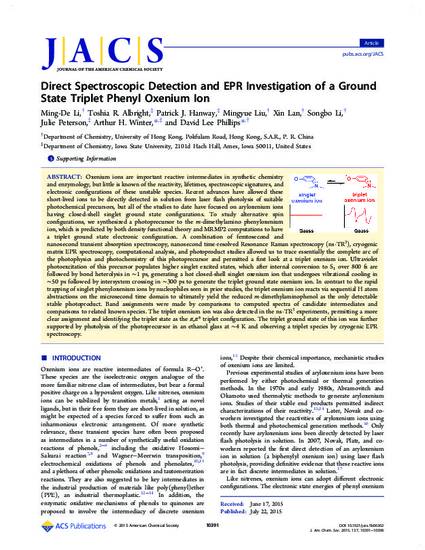
Oxenium ions are important reactive intermediates in synthetic chemistry and enzymology, but little is known of the reactivity, lifetimes, spectroscopic signatures, and electronic configurations of these unstable species. Recent advances have allowed these short-lived ions to be directly detected in solution from laser flash photolysis of suitable photochemical precursors, but all of the studies to date have focused on aryloxenium ions having closed-shell singlet ground state configurations. To study alternative spin configurations, we synthesized a photoprecursor to the m-dimethylamino phenyloxenium ion, which is predicted by both density functional theory and MRMP2 computations to have a triplet ground state electronic configuration. A combination of femtosecond and nanosecond transient absorption spectroscopy, nanosecond time-resolved Resonance Raman spectroscopy (ns-TR3), cryogenic matrix EPR spectroscopy, computational analysis, and photoproduct studies allowed us to trace essentially the complete arc of the photophysics and photochemistry of this photoprecursor and permitted a first look at a triplet oxenium ion. Ultraviolet photoexcitation of this precursor populates higher singlet excited states, which after internal conversion to S1 over 800 fs are followed by bond heterolysis in ∼1 ps, generating a hot closed-shell singlet oxenium ion that undergoes vibrational cooling in ∼50 ps followed by intersystem crossing in ∼300 ps to generate the triplet ground state oxenium ion. In contrast to the rapid trapping of singlet phenyloxenium ions by nucleophiles seen in prior studies, the triplet oxenium ion reacts via sequential H atom abstractions on the microsecond time domain to ultimately yield the reduced m-dimethylaminophenol as the only detectable stable photoproduct. Band assignments were made by comparisons to computed spectra of candidate intermediates and comparisons to related known species. The triplet oxenium ion was also detected in the ns-TR3 experiments, permitting a more clear assignment and identifying the triplet state as the π,π* triplet configuration. The triplet ground state of this ion was further supported by photolysis of the photoprecursor in an ethanol glass at ∼4 K and observing a triplet species by cryogenic EPR spectroscopy.
Available at: http://works.bepress.com/arthur_winter/10/

Reprinted (adapted) with permission from J. Am. Chem. Soc., 2015, 137 (32), pp 10391–10398. Copyright 2015 American Chemical Society.